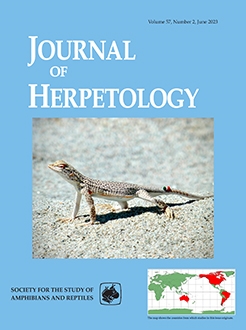Sex ratio is a key demographic characteristic indicative of the condition of populations. Despite over 70 yr of study, researchers have not fully evaluated morphological characteristics that differentiate sex in Jemez Mountains Salamanders (Plethodon neomexicanus; federally endangered). Populations of this endemic salamander, which are distributed in north-central New Mexico, have undergone declines in the past two decades. We assessed morphological characters of 160 preserved P. neomexicanus specimens, evaluated our ability to infer sex in the field, and tested our ability to determine sex on a subset of preserved specimens. In preserved salamanders with body length (i.e., postcloaca snout–vent length, SVLp) ≥ 55 mm, females exhibited greater total length, trunk length, tail length, and cloaca length, and males exhibited greater precloacal tail width, head length, head width, and head height. We documented weakly female-biased size dimorphism. Females with SVLp ≥ 52 mm had cloacal rugae, whereas males with SVLp ≥ 51 mm had distinct papillose tissue in the cloaca and a cloacal cleft. In an evaluation of 30 preserved specimens, we correctly inferred sex in 97% of salamanders by cloacal characters alone. Of 29 adult salamanders captured in the field, we confidently inferred the sex of 27 individuals (16 females, 11 males) with SVL ≥ 44 mm. Thus, sex of most individuals can be correctly inferred in the field by cloacal characters. This information will aid researchers in better understanding population trajectories of this endangered species.
How to translate text using browser tools
17 July 2023
Sexual Dimorphism in Endangered Jemez Mountains Salamanders (Plethodon neomexicanus)
Nancy E. Karraker,
Rachel A. Loehman,
Samantha Cordova
ACCESS THE FULL ARTICLE

Journal of Herpetology
Vol. 57 • No. 2
June 2023
Vol. 57 • No. 2
June 2023




